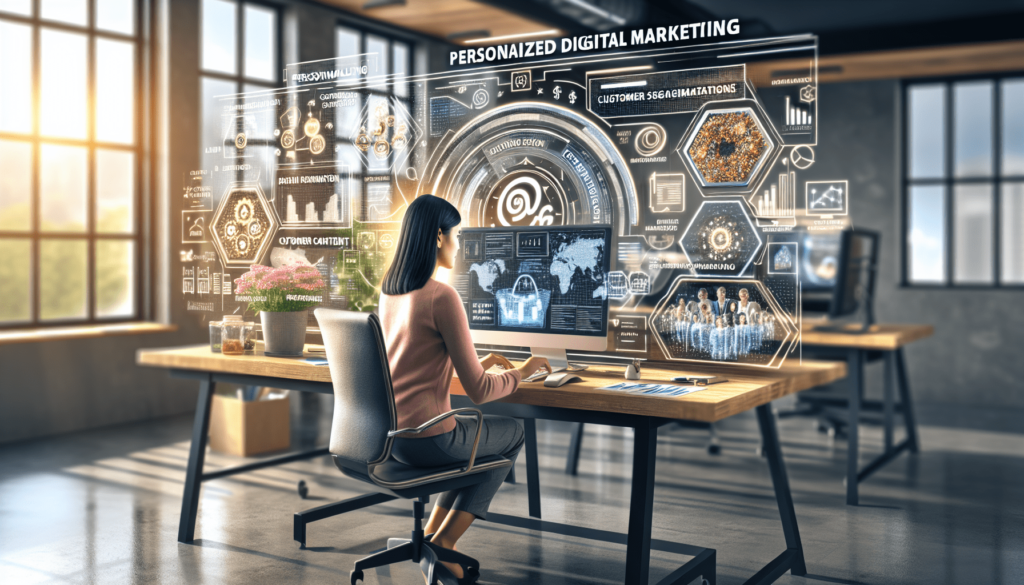Imagine having the power to tailor your digital marketing efforts to match the unique preferences and needs of each individual customer. With the rapidly advancing world of technology, this dream is now a reality. In this article, we will explore the various ways that you can personalize your digital marketing efforts to effectively connect with your target audience on a more personal level. From utilizing data analytics to crafting personalized email campaigns, get ready to take your marketing strategy to new heights.
Understanding Your Target Audience
To effectively personalize your digital marketing efforts, it’s crucial to first understand your target audience. Collecting and analyzing customer data is the foundation for creating a personalized marketing strategy. By gathering data such as demographics, purchase history, and interaction patterns, you can gain deep insights into your customers’ preferences and behaviors.
Once you have collected the necessary customer data, the next step is to create buyer personas. These are fictional representations of your ideal customers, based on real data and research. By developing detailed personas, you can better understand the needs, motivations, and pain points of different segments within your target audience. This knowledge allows you to tailor your marketing messages and campaigns more effectively.
Segmenting Your Audience
Segmenting your target audience involves dividing them into smaller groups based on common characteristics or behaviors. Demographic segmentation involves considering factors such as age, gender, location, income, and occupation. Psychographic segmentation, on the other hand, focuses on attitudes, values, lifestyles, and interests.
Segmentation enables you to create targeted marketing messages that resonate with specific groups within your audience. By understanding the unique needs and preferences of each segment, you can address them directly and increase the relevance of your marketing efforts. This specificity helps improve engagement and conversion rates, as you are providing personalized experiences to each segment.

Customizing Content
A key aspect of personalization is creating customized content for your audience. Personalized landing pages are one effective way to engage visitors based on their specific interests or needs. By tailoring your landing pages to different segments, you can increase relevance and drive higher conversion rates.
Dynamic content is another powerful tool for personalization. By using data on a customer’s preferences or behavior, you can automatically display content that is highly relevant to them. This could include product recommendations, related blog posts, or personalized offers. This level of customization helps drive engagement and encourages customers to take desired actions.
Sending personalized emails and offers is also crucial for effective digital marketing personalization. By utilizing customer data, you can tailor email content and promotions to specific segments or individuals. This personal touch makes customers feel valued and increases the chances of conversion.
Utilizing Behavioral Tracking
Tracking user behavior and actions on your website is essential for personalization. By understanding how visitors interact with your website, you can gain insights into their preferences and interests. This data can then be used to provide personalized recommendations, tailored content, and offers based on their behavior.
Cookies and pixels are commonly used to gather data for behavioral tracking. These technologies track a user’s actions on your website, allowing you to collect valuable information about their browsing patterns and interests. By analyzing this data, you can create a more comprehensive view of your customers and serve them personalized experiences.
Providing personalized recommendations is a powerful way to engage your audience and increase conversions. By leveraging behavioral tracking data, you can identify products or content that are likely to be of interest to individual customers. These recommendations can be displayed on your website, in emails, or through other marketing channels.

Implementing Marketing Automation
Marketing automation is a valuable tool for personalizing your digital marketing efforts. By automating certain tasks and workflows, you can deliver targeted content at specific stages of the customer journey. This automation helps ensure that customers receive the right message at the right time, increasing engagement and conversion rates.
One key aspect of marketing automation is automating email marketing campaigns. By setting up personalized workflows and triggers, you can send targeted emails based on specific customer actions or behaviors. For example, if a customer abandons their shopping cart, you can automatically send them a personalized reminder or offer to encourage them to complete their purchase.
Delivering targeted content is another important element of marketing automation. By understanding where each customer is in the buying cycle, you can provide them with content that aligns with their needs and interests. This can include blog posts, product guides, or case studies that help move them closer to making a purchase.
Using AI and Machine Learning
Leveraging artificial intelligence (AI) and machine learning can take personalization to the next level. Predictive analytics, a branch of AI, allows you to forecast future customer behavior based on historical data. By analyzing patterns and trends, you can identify customers who are most likely to convert or churn, allowing for targeted marketing efforts.
Machine learning algorithms can also be used to personalize recommendations for individual customers. By analyzing their past behavior and preferences, these algorithms can suggest products, content, or offers that are highly relevant to each individual. This level of personalization enhances the customer experience and drives higher engagement.
Creating chatbots for personalized customer interactions is another application of AI and machine learning. Chatbots can provide real-time assistance and support to customers, based on their specific queries or needs. By leveraging AI technologies, chatbots can understand natural language and provide personalized responses, creating a more human-like interaction.
Leveraging Social Media
Social media platforms provide a wealth of data that can be used to personalize your marketing efforts. By monitoring and analyzing social media interactions, you can gain insights into customer preferences, sentiments, and behavior. This information allows you to tailor your content and advertising to specific segments of your audience.
Targeted advertising on social media is particularly effective for personalization. By using the data collected from social media interactions, you can craft highly targeted ads that resonate with specific segments of your audience. This level of personalization helps increase click-through rates and conversion rates, as the ads are more relevant to the viewer.
Engaging with customers through personalized content is another way to leverage social media for personalization. By providing content that is tailored to each social media platform, you can increase engagement and foster a sense of community with your audience. This personalized approach helps build strong relationships and brand loyalty.
Optimizing Website and User Experience
Creating a user-friendly and personalized website is essential for a successful digital marketing strategy. By analyzing user data and understanding their preferences, you can design a website that provides a personalized experience for each visitor. This can include features such as personalized product recommendations, dynamic content, or customized navigation menus.
Implementing personalization techniques such as dynamic content or tailored landing pages can significantly improve the user experience. By presenting visitors with content that is customized to their needs or interests, you can increase engagement and reduce bounce rates. This level of personalization makes visitors feel valued and encourages them to explore further.
A/B testing is another valuable tool for optimizing personalized content and the user experience. By comparing different versions of personalized content, you can determine which variation performs better in terms of engagement or conversion rates. This data-driven approach helps refine your personalization efforts and ensures that you are providing the best experience for your audience.
Incorporating Personalized Advertising
Personalized advertising is a powerful way to engage with your audience and increase conversion rates. Programmatic advertising allows you to automate the buying and selling of ad space, enabling you to deliver personalized campaigns at scale. By utilizing customer data, you can target specific segments with customized messages and creative.
Retargeting is another effective strategy for personalized advertising. By tracking customers who have visited your website or interacted with your brand, you can show them personalized ads on other websites they visit. This constant reminder of your brand helps keep you top of mind and encourages them to return and make a purchase.
Geo-targeting is particularly useful for localized advertising. By leveraging geographic data, you can deliver ads that are relevant to customers based on their location. This can include promoting special offers or events that are happening in their area. Geo-targeting helps increase the effectiveness of your advertising and ensures that you are reaching the right people at the right time.
Leveraging Customer Feedback
Gathering feedback and reviews from customers is invaluable for personalization efforts. By listening to your customers and understanding their needs and preferences, you can continuously improve your personalization strategy. Customer feedback provides insights into what is working well and areas that need improvement.
Implementing customer satisfaction surveys is one effective way to gather feedback. These surveys can be sent after a customer has made a purchase or interacted with your brand. By asking specific questions about their experience and satisfaction level, you can gain valuable insights into how well your personalization efforts are resonating with your audience.
Using feedback to improve personalization efforts is crucial for ongoing optimization. By analyzing customer feedback, you can identify areas where personalization can be enhanced or areas where it may be falling short. This feedback-driven approach allows you to continuously refine and improve your personalized marketing efforts, ensuring that you are always delivering the best possible experience to your audience.
In conclusion, personalizing your digital marketing efforts is essential for driving engagement, conversions, and customer loyalty. By understanding your target audience, segmenting them based on common characteristics, and customizing content, you can create personalized experiences that resonate with each individual. Utilizing behavioral tracking, implementing marketing automation, and leveraging AI and machine learning enhance personalization efforts. Additionally, leveraging social media, optimizing your website and user experience, incorporating personalized advertising, and leveraging customer feedback all contribute to successful personalization strategies. By adopting these practices, you can create powerful and effective digital marketing campaigns that deliver exceptional customer experiences.

